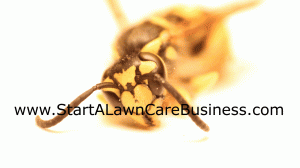Hi Everyone, this is Keith with StartALawnCareBusiness.com
Bees and wasps are hazards to every lawn care business owner and late summer through Autumn is a time of increased bee and wasp activity. I found this nest in a lawn recently. It was very easy to see the yellow jackets flying to and from the nest so I decided to put a camera on a tripod. I was able to film them for a few minutes and they did not seem to notice I was there.
However, they eventually became annoyed and attacked my camera.
The yellow jackets in this video are most likely Eastern Yellow Jackets (Vespula maculifrons) from the order hymenoptera(1). They are highly territorial and will aggressively defend their nest when they feel threatened.
According to the National Institutes of Health, deaths attributable to Hymenoptera account for more than 79 fatalities per year in the United States(2). Though most stings can be remedied through treatment at home, up to 10 percent of stings result in more extreme reactions requiring elevated care(3). This statistic is especially concerning for lawn care business owners who spend their days on lawns and in flower beds where ground burrowing hymenoptera like to build their nests.
What is also concerning to lawn care business owners is that some hymenoptera, especially ground dwelling vespid wasps such as yellow jackets, are particularly sensitive to the vibrations of lawn mowers and string trimmers. Given that a typical colony of yellow jackets can contain from a few hundred to several thousand individual wasps(4) it behooves anyone operating a lawn mower or other lawn care equipment to remain vigilant during late summer and autumn months when yellow jacket populations swell and become most active.
Although annoying, yellow jackets are beneficial to our ecology. They kill flies as well as caterpillars and beetle larva(5) which do damage to ornamental and vegetable garden plants. Yellow Jackets are also adept at scavenging fallen fruits from trees. And, since they eat raw meat they help clean up road kill and other dead animals. So, due to their beneficial nature, unless a Yellow Jacket nest poses a threat to humans or pets, I normally leave it alone until winter time. The wasps die sometime after the first few frosts and I can then dig up and destroy the nests without fear of being stung.
If you find it necessary to destroy a yellow jacket nest in the duty of your lawn care business, think carefully about a few things.
1) If you apply any chemical to a customer’s lawn or landscaping in the course of your lawn care business you will likely require an applicator’s license(6). Now, I know a lot of people laugh at this advice. Many people operating their own lawn care companies think they can purchase an over the counter wasp and hornet spray and use it to kill yellow jackets in their customer’s lawns. You might get away with it, but, technically, in many states, you should have an applicator’s license before applying any chemicals including wasp spray.
2) If the pesticide control board catches you applying a pesticide without an applicator’s license, you will face a fine which can amount to several hundred dollars. I even know of one lawn care business operator that was fined $5,000 for applying a pesticide without an applicator’s license.
3) If someone is injured while you are applying a pesticide to a yellow jacket’s nest , you could be held responsible for their injuries.
Also, please don’t ever pour gasoline or any other unapproved chemical into the ground. I have seen videos and blogs where people talk about pouring gasoline into yellow jacket nests. We know better, these days, than to do things like that. It pollutes the ground and, from a business standpoint, it sets you up for criminal and civil charges if you are ever caught doing it.
If a nest must be removed, have your customer call a licensed pest control management company to perform the extraction.
Knowing that they are a threat, there are steps you can take to avoid the dangers of yellow jackets.
1) Ask your lawn care customers to inform you of any yellow jacket activity in their lawns.
2) Be observant. Watch for yellow jackets flying to and from their nests. You can often see yellow jacket activity long before your lawn mower disturbs them.
3) Mark nest sites with marker flags. You can avoid the nests during the late summer and fall active months and then come back in the winter to dig the nests up and destroy them once the yellow jacket have left their nest.
4) Wear long pants and other protective clothing.
5) Know your sensitivity to stings and carry an epipen if necessary.
One of the reasons many of us enter the lawn care business is our love of the outdoors and nature. Bees and wasps are simply part of the outdoors and they are some of the creatures sharing our earth. It is unfortunate that they are so territorial and sting so violently when they feel threatened. However, that is just their way of protecting themselves. They are not actively seeking people to sting(7). So, when you encounter yellow jacket nests, do your best to avoid contact and leave them alone and avoid getting stung. They will be gone when the weather cools. If you can’t avoid yellow jackets, use an Integrated Pest Management approach and try to do as little ecological damage as possible.
Once again, this is Keith with StartALawnCareBusiness.com. If you are thinking about starting your own lawn care business, we have developed a professional and comprehensive lawn care business strategy guidebook and estimating software program that will help you start and operate a successful lawn care business. You can learn more about this program and purchase it through our main website: http://www.StartALawnCareBusiness.com
(1) http://entnemdept.ufl.edu/creatures/urban/occas/hornet_yellowjacket.htm
(2) http://www.ncbi.nlm.nih.gov/pubmed/22656661
(3) http://www.mayoclinic.com/health/bee-stings/DS01067/METHOD=print
(4) http://pods.dasnr.okstate.edu/docushare/dsweb/Get/Document-2284/F-7305webcolor.pdf
(5) http://espsciencetime.org/student_life.cfm?subpage=327295
(6) http://extension.osu.edu/news-releases/archives/2010/february/pesticide-application-training-being-offered
(7) http://gregsnaturalhistory.com/623/yellow-jackets-hummingbirds/
